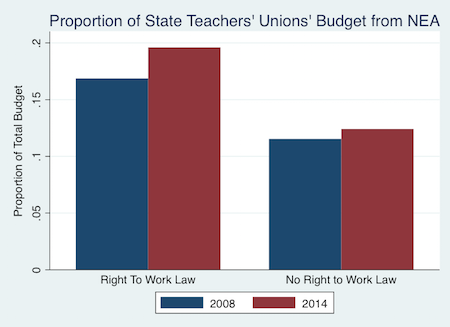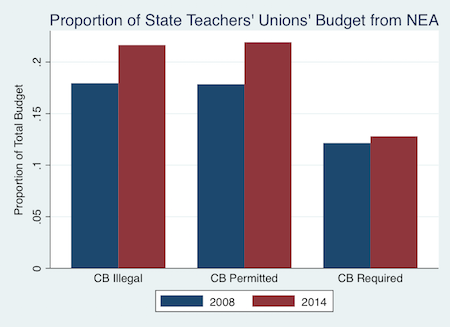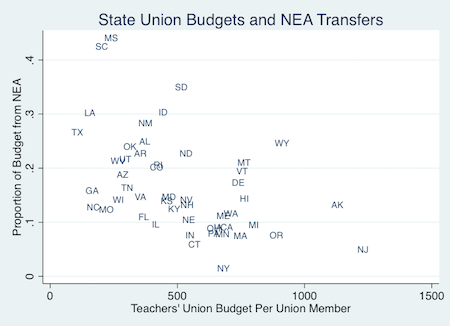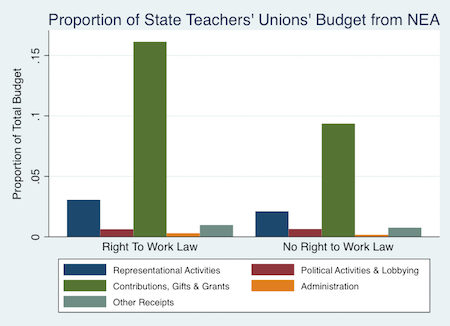Last Tuesday, the Supreme Court issued a 4-4 ruling in Friedrichs v. California Teachers Association. The deadlocked decision, anticipated since the death of Justice Antonin Scalia, preserves Ninth Circuit Court’s ruling in favor of the California Teachers Association (CTA) and upholds the constitutionality of public sector agency fees.
The ruling was a big win for teachers’ unions, but not just in the states that will maintain their agency fees. Teachers’ unions in states with right to work laws rely on the funds transferred from their counterparts in states with agency fees. If agency fees were deemed unconstitutional, teachers’ unions in right to work states would have a harder time recruiting and supporting members. In other words, a blow to agency fees would be a blow to the organizational capacity of teachers’ unions in all states.
The Consequences of Friedrichs
The Friedrichs case has generated ample speculation over what it would mean for public sector unions if agency fees were declared unconstitutional. Some see a ruling in favor of Friedrichs as spelling the end of public employee unions, while others believe that such a decision would not make a large difference. Still others argue that Friedrichs would force a reinvigoration of the labor movement by forcing unions to justify themselves to potential dues payers.
Those who argue that a ruling in favor of the plaintiffs would mean disaster for teachers’ unions base their argument in the classic free rider dilemma. The logic is that all employees benefit from the policies negotiated by the union in collective bargaining, regardless of whether they are members. The fee forces employees to pay their fair share for those benefits, rather than “free ride” on the benefits they otherwise enjoy without expending any cost.
As a result, employees are more prone to be members in states with agency fees. Agency fees are usually deducted automatically along with membership dues. Cancelling membership requires actively opting out, giving up additional benefits, like vacation discounts and vision insurance. Why not remain a member and get something for the money you have to spend anyway since it is less effort than the alternative?
For these reasons, many have argued that without agency fees, union membership and resources would fall as employees free ride rather than join unions. Consistent with that logic, states with right to work laws have lower membership rates than states without such laws in place. Several analysts have cited Wisconsin’s Act 10, which banned agency fees and severely curtailed collective bargaining, as a harbinger of things to come should the constitutionality of agency fees be overturned: union membership nose-dived, falling by as much as 50 percent.
Others have countered that many states have been without agency fees for years –and teachers’ unions have done just fine in those states. They concede that because of the free rider problem, teachers’ unions may have to work harder to keep members, but the unions will ultimately survive. They point out that Act 10 did much more than get rid of agency fees. In a blog post, labor scholar Jake Rosenfeld makes this point and emphasizes that right to work laws are not destiny – union recruitment efforts matter. He cites right to work Indiana, where teachers’ unions have increased membership in recent years, while it has fallen in agency fee states like Michigan and Ohio.
In a piece for Education Next, Mike Antonucci also argues that the consequences of Friedrichs are being overstated. He explains that overturning agency fees “would simply mean that the current situation in states such as Texas and Georgia would become the norm in California and the rest of the U.S.” As in states without agency fees, he argues, teachers’ unions would continue to lobby, support candidates, interact with school boards, and where they can collectively bargain, represent teachers in collective bargaining.
One element that has been left out of this conversation is the fact that each state does not operate in a void. The federated structure of the American Federation of Teachers (AFT) and the National Education Association (NEA) allows for redistribution of funds across states. Unions in states with unfavorable labor law that are able to function without agency fees do so partly because they have support from the states that do have agency fees. This means that if agency fees were deemed unconstitutional, teachers’ union organizational capacity would be seriously harmed across the country, especially in states that already prohibit agency fees, which are already faced with smaller budgets and adverse labor conditions.
Redistribution of Funds Across States
It is far from clear that teachers’ unions can continue to function just fine in the absence of favorable state-level labor laws. There is evidence that teachers’ unions in states with right to work laws and without collective bargaining benefit from the redistribution of resources from states without these laws.
Transfers of funds across states have aided unions in right to work states and those without collective bargaining since the 1970s. In his dissertation, Michael Hartney provides evidence that in the years following the passage of collective bargaining laws, the NEA utilized funds from organized states to increase the capacity of affiliates in states without collective bargaining. State affiliates established political action committees and gained additional staff only after their counterparts in states with collective bargaining had done so. Others have described how NEA’s Uniserv program, which aids collective bargaining, provides professional assistance to members, and builds organizational capacity, was first established to help weak locals.
There is evidence that this redistribution continues to present day. I collected data from the NEA’s 2014 and 2008 tax forms (Form 990) and recorded how much was sent to each state affiliate. State teachers’ unions in states with unfavorable labor laws receive a higher proportion of their budget from NEA’s national office than those without. Figures 1 and 2 demonstrate that affiliates in states with right to work laws or without required collective bargaining receive around 20 percent of their budgets from the national organization. Affiliates in states without right to work laws or with mandatory collective bargaining receive around 12 percent of their budgets from the NEA.
Figure 1

Figure 2

The importance of the transfers that state affiliates receive from the national union is clear when one considers that teachers’ union budgets in states with unfavorable labor law are much smaller than in states with more favorable labor regimes. Figure 3 shows the relationship between the state affiliates’ budgets (per full-time teacher that is a union member) and their transfers from the NEA. It demonstrates that states that receive a higher percentage of their budget from the NEA are also those that have smaller budgets overall. Those states that are most dependent on the NEA are those with the most restrictive labor laws – collective bargaining is illegal in Texas, South Carolina, and North Carolina, while Mississippi permits collective bargaining but is a right to work state. On the other hand, those with the largest budgets and that receive the least from the NEA are some of the states with the strongest labor laws – New Jersey, New York, Alaska, Oregon.
Figure 3

It is important to note that these transfers are not going primarily to political activities. Rather, they are going primarily to representational activities, Uniserv, and training. I coded the different types of disbursements listed on the NEA’s LM-2 tax form. Figure 4 lists the percentage of state affiliates’ total budget that came from NEA funds in each category in 2015. The figure shows that there is no difference in the percentage going toward political activities across right to work and non-right to work states.
Rather, the main difference in the disbursements going to the two types of states is in terms of “gifts, grants, and contributions.” This category consists largely of funds for Uniserv and staff training. In other words, these funds help with membership representation, professional assistance, and recruitment. While there is a strong argument that these activities bleed into political advocacy, their immediate functions are organizational. The other category for which there is a statistically significant difference between the two groups is representational activities, which primarily consist of litigation costs.
Figure 4

Altogether, the evidence presented here suggests that NEA affiliates in states without collective bargaining and with right to work laws rely on funds from other states. These funds are crucial in supporting legal efforts, recruitment and representation of members.
Bringing it Back to the Case
At the heart of the case was the issue of whether agency fees infringe on public sector workers’ First Amendment rights to political speech. In the 1977 Abood decision, the Supreme Court ruled that agency fees were constitutional – so long as those fees were not used by unions for political purposes. The Court worried that mandatory fees directed towards political ends would be a form of compulsory political speech for workers. In Friedrichs, the plaintiffs – teachers who disagreed with the politics of their union – argued that the act of collective bargaining is inherently political, and thus by being forced to support an organization they do not agree with, their free speech is being violated. A ruling in favor of Friedrichs would have meant the end of agency fees in 25 states that allow such charges.
With Tuesday’s ruling, teachers’ unions have avoided that blow. However, this is not the end of the issue. The plaintiffs plan to petition the court to rehear the case once there are nine justices back on the bench. The National Right to Work Foundation reported in a press release last week that there are five other similar cases already making their way through the courts. One way or another, this issue is sure to come before the Supreme Court again.
The results presented here suggest that if agency fees were ruled unconstitutional, states that currently have agency fees would not simply readjust to operate more like their right to work counterparts. Rather, all teachers’ unions in all states would suffer – and especially the states that are already operating under unfavorable labor law. Given that much of the funding redistribution goes toward recruitment, it might well generate a vicious downward cycle, as recruitment efforts become increasingly more difficult.
A ruling in favor of the Friedrichs plaintiffs – or plaintiffs in future cases like it – would mean less money to support members in all states, even those that are not directly affected by the ruling. The consequences could be greater than has been previously acknowledged.
—Leslie Finger
Leslie Finger is a Ph.D. student in the Department of Government at Harvard University.


